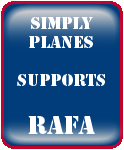Boeing Vertol CH-47 Chinook
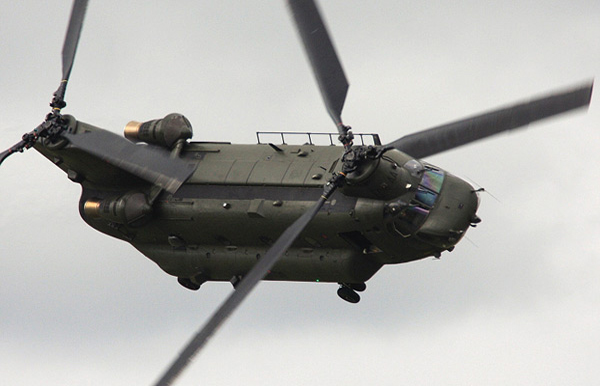
Boeing Vertol HC2 (CH-47D) Chinook MA-001/B-812/M-7032 ZA670/AA. Photo by Bruce Martin
The Boeing Vertol CH-47 Chinook, a twin-engine, tandem rotor, heavy lift cargo helicopter. Developed from the Vertol Model 107, its first flight was on 21st September 1961. The Chinook is easily recognisable by the two rotor blades and can reach speeds of up to 170 knots (196 mph, 315 km/h), this made it one of the fastest helicopters of the ’60s. There have been over 1,179 Chinooks built since the early 1960s. The main roles of the Chinook have been troop movement, artillery emplacement and battlefield resupply. The Chinook was originally designed by Boeing Vertol but is now produced by Boeing Integrated Defense Systems. The Chinook helicopter has been sold to various nations including the Netherlands and Japan.
During 1956 The Department of the Army were looking to design a turbine-powered aircraft to replace the current piston-engined CH-37 Mojave. A design competition was held in September 1958 and it was recommended by a joint Army-Air Force source selection board that the Army should use the Vertol medium transport helicopter. Others felt that the new helicopter should be bigger to have the ability to be used as an artillery prime mover and also to accommodate the Pershing Missile System. Vertol started work on a new tandem rotor helicopter with the designated name Vertol Model 107 or V-107 during 1957. Vertol was awarded a contract by the US Army in June 1958 for the aircraft under the YHC-1A designation. After being tested the YHC-1A was deemed too heavy for the assault role and also too light for the transport role. It was decided that a heavier transport helicopter was needed. The YHC-1A was improved and adopted by the marines as the CH-46 Sea Knight in 1962. The army ordered the larger model, the HC-1B. The HC-1B was redesignated CH-47A under the 1962 United States Tri-Service Aircraft Designation System. The name Chinook was taken from the Chinook people of the Pacific Northwest.
Over the years various models of Chinook helicopters have served in the Vietnam War, Iran-Iraq War, Falklands War and the UH-60 Black Hawks in Iraq and Afghanistan.
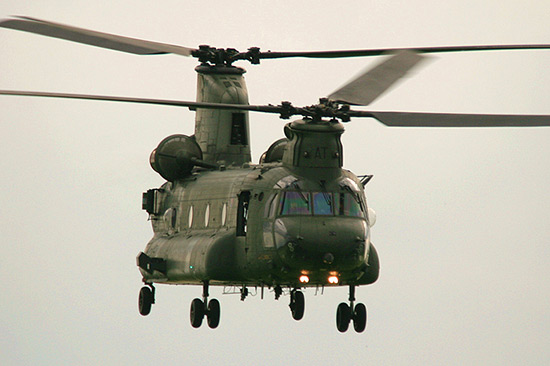
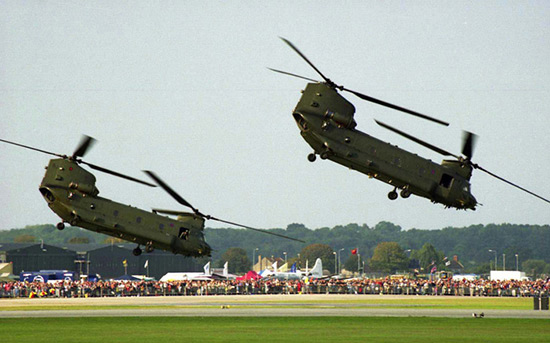
Boeing Vertol CH-47 Chinooks. Images courtesy of Chris Cannon, Bruce Martin and Bob Franklin
Chinook Centenary Specials Event
An event with a very distinct first and last theme took place in the skies over southern England on the afternoon of 14 September 2016.
Three Boeing Chinook HC.4 helicopters from RAF Odiham’s Nos 18 (B) (ZA712), 27 (ZA683) and RAF Benson’s 28 (ZH777) Squadrons took part in a formation photographic sortie from Odiham. This was the first time all three centenary marked Chinooks had been seen collectively together.
Before the flight departed an opportunity was afforded to a small group of media and invited guests to photograph the three Chinooks on Odiham’s ramp.
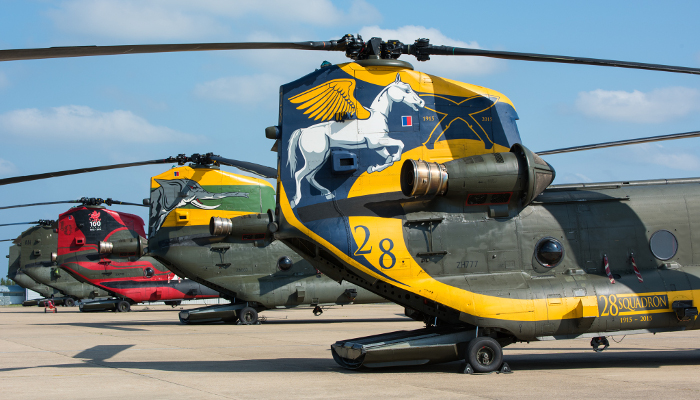
Image courtesy of Richard Hall
For once the unpredictable British weather on the day was fine and sunny, as the air and ground crews prepared the three helicopters for their flight south. In company with the Chinooks, a Westland Lynx AH.9A (ZG916) from No 657 Squadron AAC acted as the formations photoship.
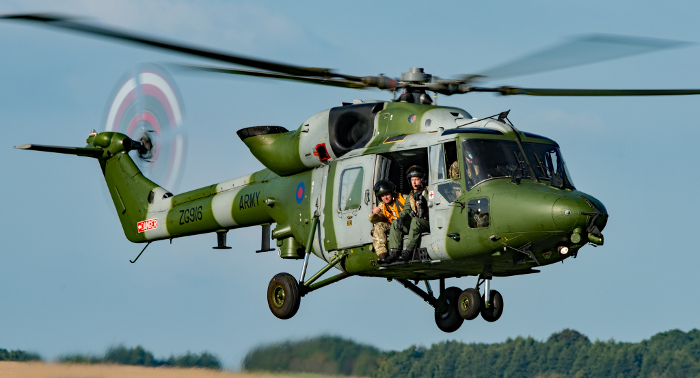
Image courtesy of Richard Hall
At the allotted time the familiar thump of the Chinook’s rotor blades and the underlying whine of their Lycoming T-55 engines were heard as each helicopter went through their pre-flight checks. The Chinooks, with ZA683, leading then taxied and positioned themselves for the Lynx to take a number of photographs of the helicopters in the hover, looking back towards Odiham’s hangars and ramp.
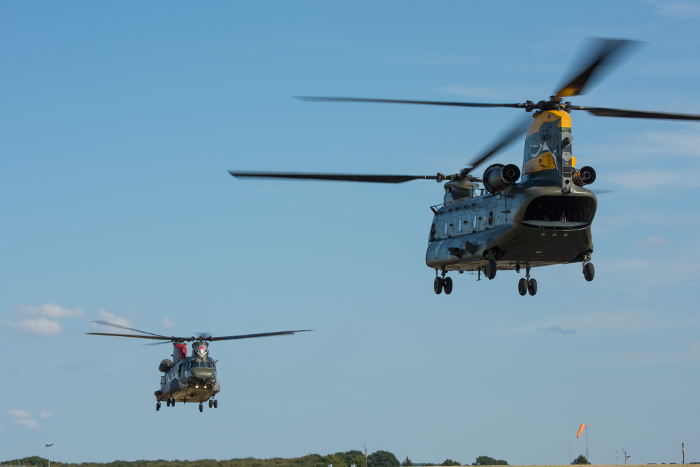
Image courtesy of Richard Hall
Following this the formation departed on their flight to the South Coast where they overflew Selsey, Portsmouth, Cowes and the Needles. The flight then turned inland and headed for one of the Chinooks regular training grounds, the Salisbury Plain Training Area, where a number of photographers were gathered to record the scene.
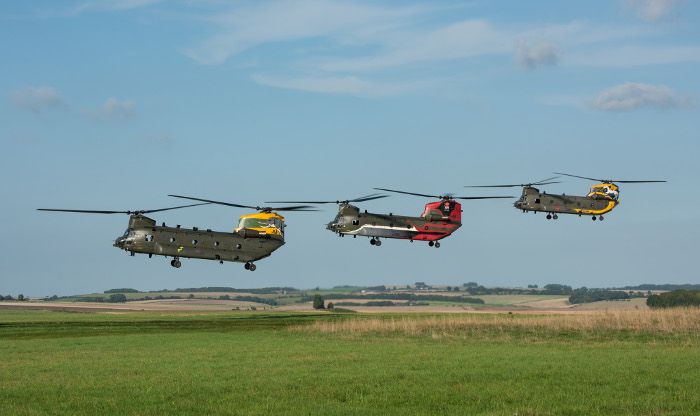
Image courtesy of Richard Hall
After spending over half an hour on the Plain, in which time the Chinook’s positioned themselves so that each Squadron had a turn at leading, the three helicopters returned to Odiham accompanied by their Lynx photoship.
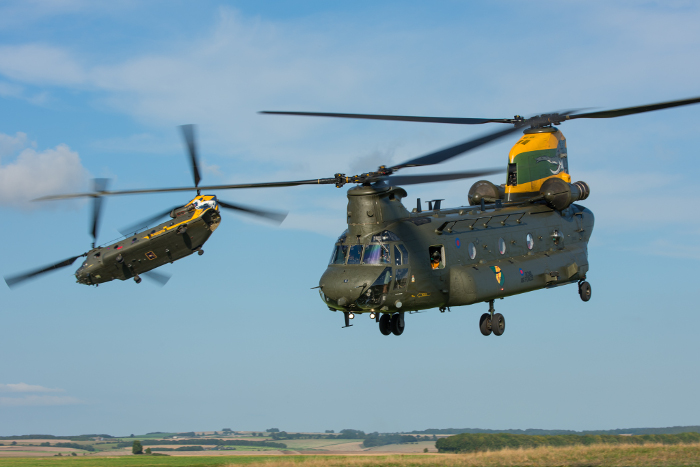
Image courtesy of Richard Hall
Whilst the three helicopters have often been seen individually, this was the first time all three had been observed together and according to RAF sources, is highly likely to be the last.
Origins of the Artwork
In 2015 and 2016 each Chinook had special artwork applied to commemorate their respective squadron’s centenaries. The artwork was designed by Chinook pilot Flight Lieutenant Andy Donovan (who also organised the photographic sortie and choreography) and was applied by a specialist team from Serco.
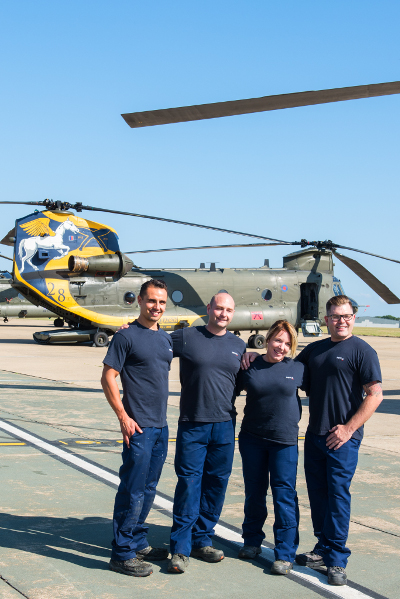
Image courtesy of Richard Hall
18 (B) Squadron
This was the first of the trio of Chinooks to have the centenary colour scheme applied in May 2015 at RAF Odiham.
No 18 Squadron was formed at Northholt in May 1915 and at the time formed part of the Royal Flying Corps. The Squadron’s badge features a rampant Pegasus which was approved for use by King Edward VIII in May 1936. In World War One the Squadron co-operated with the Cavalry Corp at the time of the Somme Offensive and Pegasus was chosen to commemorate this historic connection.
The scheme applied to the 18 Squadron Chinook within its design encompasses the Squadron’s transition from 1915 through to 2015. There is a great deal of thought gone into this scheme which includes the change of colour of Pegasus from white to red in 1936, through recognition of the Squadron’s participation in World War 2, operating the Canberra and present day operations. The finishing touch is the incorporation of 18’s motto Animoet fide (With courage and faith).
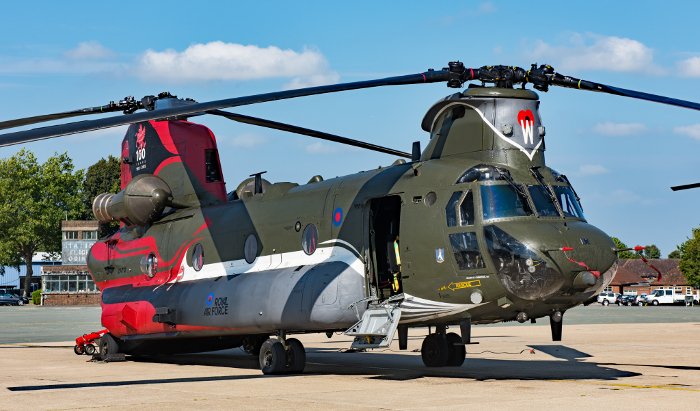
Image courtesy of Richard Hall
27 Squadron
On 5 November 1915 No 27 Squadron was formed as part of the Royal Flying Corps at Hounslow Heath Aerodrome. Initially equipped with the Martynside G.100 Elephant bi-plane, which was deemed to be a fighter, No 27 went on to utilise the aircraft for reconnaissance and bombing, a role for which it was more suited.
The Elephant is a fairly unknown aircraft but it went onto to feature within the Squadron’s official badge with the latin motto of, "Quam celerrime ad astra", which translates into, "With all speed to the stars".
The centenary paint scheme was applied to the Chinook at RAF Odiham unveiled on 5 November 2015.
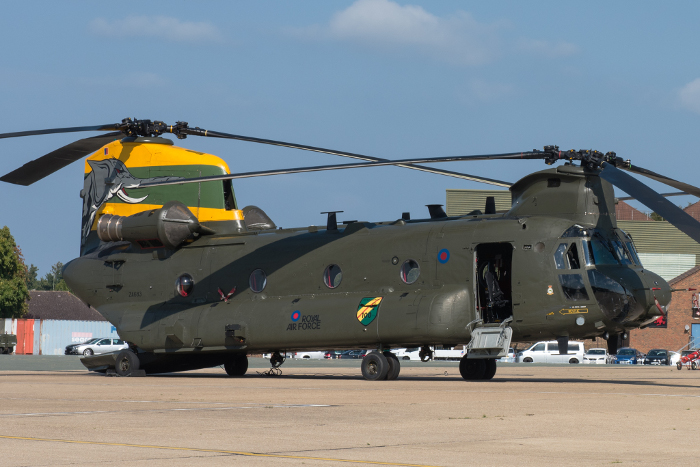
Image courtesy of Richard Hall
28 Squadron
No 28 was formed on 7 November 1915 at Gosport but due to a number of changes that were taking place at the time, it was not been possible for the Squadron to celebrate its centenary until a later date. The 7 April 2016 was chosen to mark the event as it was also the day the Squadron moved into its new hangar facilities at RAF Benson in Oxfordshire.
The Squadron’s badge features a demi-Pegasus and fasces which was approved in 1936 by King Edward VIII. The demi-Pegasus represents the white horse carved into the chalk near Yatesbury, No 28’s first operational base, whilst the fasces commemorates the Squadron’s service in Italy in World War One.
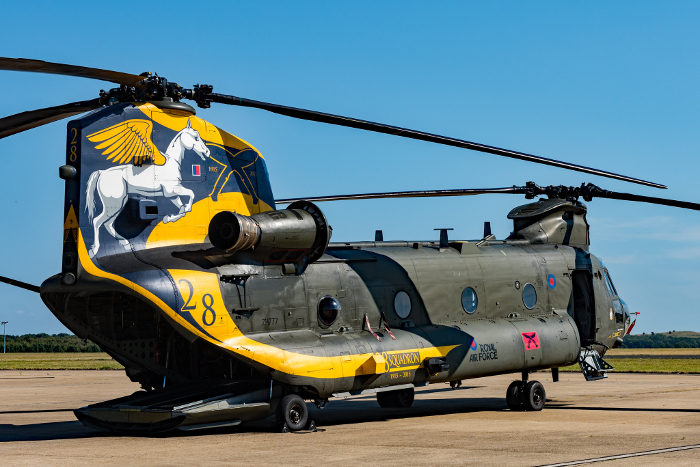
Image courtesy of Richard Hall
Richard Hall – in conjunction with www.simplyplanes.co.uk
With thanks to Flt Lt Nyssa Cole at RAF Odiham for making the arrangements and Chris Cannon (Simply Planes) for the invitation to attend the event.
100 Years Of No 28 Squadron
No 28 Squadron was formed on 7 November 1915 at Gosport but due to a number of changes that have been taking place, it has not been possible for the Squadron to celebrate its centenary until now. The date of 7 April 2016 was chosen to mark the event and it was also the day the Squadron moved into its new hangar facilities at RAF Benson in Oxfordshire.
Operational since October 2015, 28 Squadron operates as the combined Chinook and Puma Operational Conversion Unit (OCU), the two former OCUs for the respective helicopter types merging in order to provide the best value for money for defence and the tax payer. 28 Squadron’s role is to produce front line aircrew for RAF Benson (Puma) and RAF Odiham(Chinook), in order to supply helicopter lift capabilities to the British Army, Royal Marines and other Defence and Government agencies. The Pumas and Chinooks are used to provide troop transportation, casualty evacuation, re-supply, disaster relief (as seen during the recent UK floods) and military aid to the civil community.
As well as using live aircraft the Squadron utilises state of the art flight simulation to train its Support Helicopter aircrew. Students arriving at 28 Squadron will have initially trained at RAF Shawbury in the basics of helicopter flying before moving to the OCU to convert onto the Puma and Chinook. The training will include dealing with underslung loads, flying at low level, in cloud and at night.
The Squadron’s badge features a demi-Pegasus and fasces which was approved in 1936 by King Edward VIII. The demi-Pegasus represents the white horse figure carved into the chalk near Yatesbury, No 28’s first operational base, whilst the fasces commemorates the Squadron’s service in Italy World War One. Their motto is QuicquidAgas Age which translates into Whatsoever you may do, do.
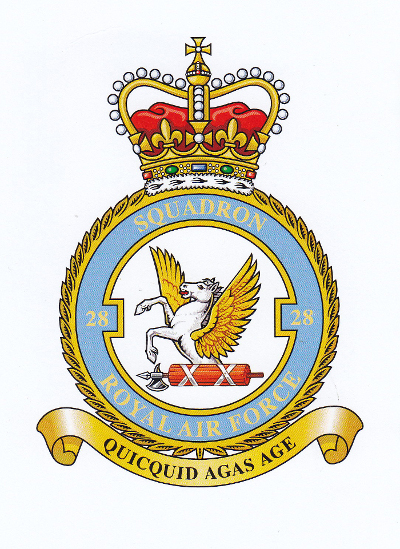
In celebration of the centenary two of the Squadron’s helicopters, Chinook HC.4 ZH777 and Puma HC.2 ZJ954 were suitably adorned with a special paint scheme and decals which feature elements of the Squadron’s badge.
The Chinook has had a demi-Pegasus painted onto the helicopter’s tail rotor pylon together with the Gurkha Flash of 48 Gurkha Infantry Brigade. The Kukri Flash commemorates 28 Squadron’s former forty year association with the Gurkhas which ended in 1994. The Squadron was asked by the Brigade to wear the Flash to remember its connection with the Gurkhas, a tradition that continues to this day.
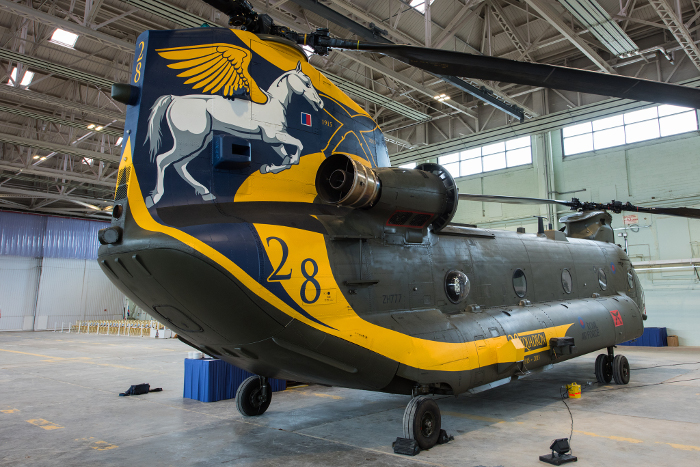
The Puma has had decals applied to the main doors which can easily be removed should the helicopter be required for rapid deployment.
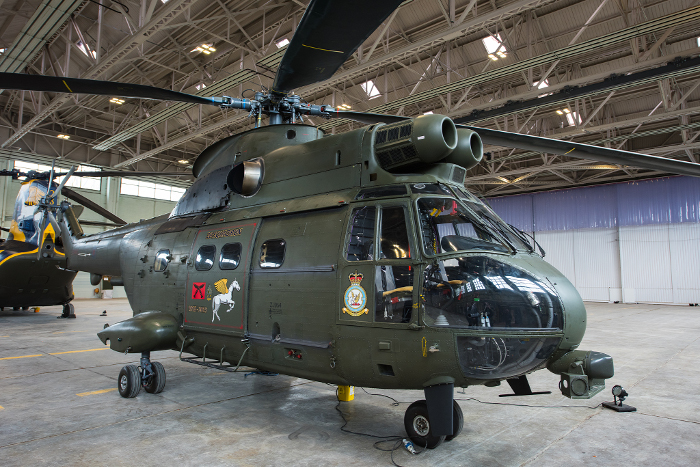
On the day of the event, Squadron members were joined by former Commanding Officers for a formal Royal parade in their newly refurbished hangar. The parade of over ninety RAF personnel was reviewed by Prince Michael of Kent GCVO with a backdrop provided by the Chinook and Puma. As the music, provided by the Band of the Royal Air Force Regiment, played and the personnel marched it felt like all those who had gone before in No 28’s long history were present within the hangar if not in body but in spirit.
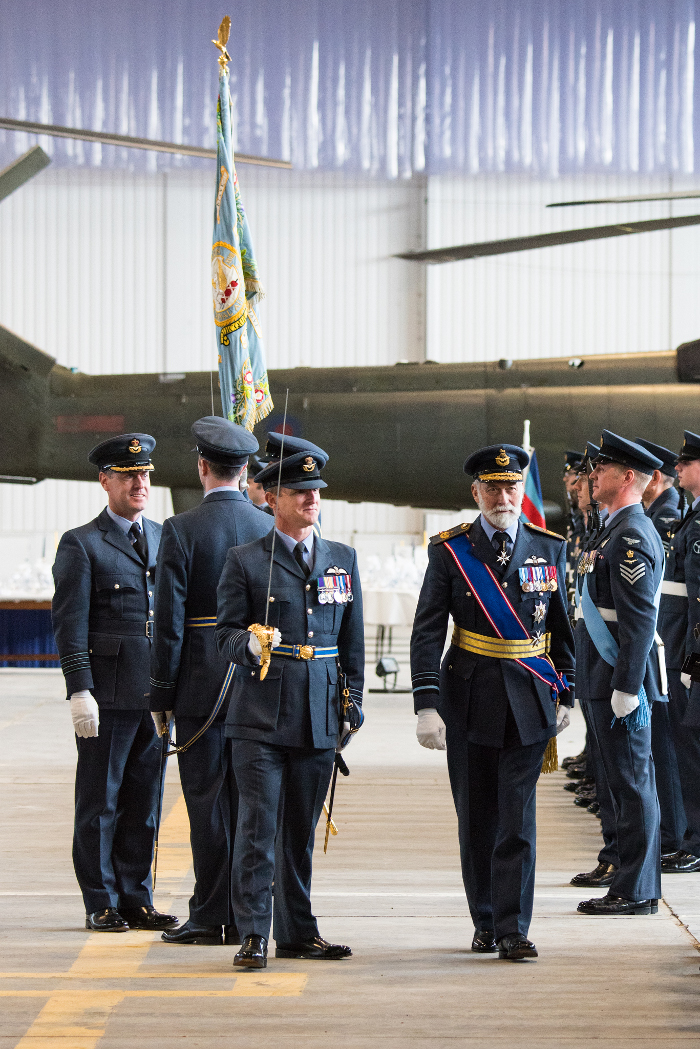
Wing Commander Marty Lock, the Officer Commanding of No 28 Squadron and the Parade Commander said the following "I am honoured to command a squadron with such an illustrious history and an exceptionally bright future. We are always mindful of the Squadron’s heritage and our actions today honour all those who have served 28 Squadron previously. Today I have the privilege to command a Squadron of dedicated and passionate personnel, from engineers, operations, admin and safety equipment staff to the students and the instructors who provide the training, all of whom allow 28 Squadron to provide the best training to all future RAF support helicopter aircrew and I am incredibly proud of all the Squadron has achieved, today and over the past century. Each and every person on 28 Squadron can be proud to say that they are now an integral part of the shaping the RAF’s Support Helicopter Force."
Report and images for Simply planes courtesy of Richard Hall.
27 Squadron celebrated their 100th anniversary on the 5th November 2015
There are few squadrons within the Royal Air Force that have such longevity as No 27. Disbanded on six occasions since its creation, the Squadron has gone on to be subsequently reformed over the past century and remains operational to this day. No 27 has taken part in many of the major conflicts over the past 100 years, including the First & Second World Wars, Suez, the Cold War and more recently, operations in the Gulf, Kosovo and Afghanistan.
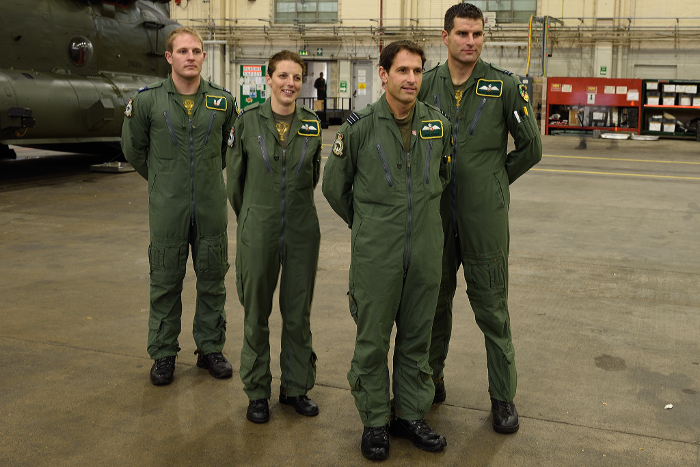
On 5 November 1915 No 27 Squadron was formed as part of the Royal Flying Corps at Hounslow Heath Aerodrome. Initially equipped with the Martynside G.100 Elephant bi-plane, which was deemed to be a fighter, No 27 went on to utilise the aircraft for reconnaissance and bombing, a role for which it was more suited.
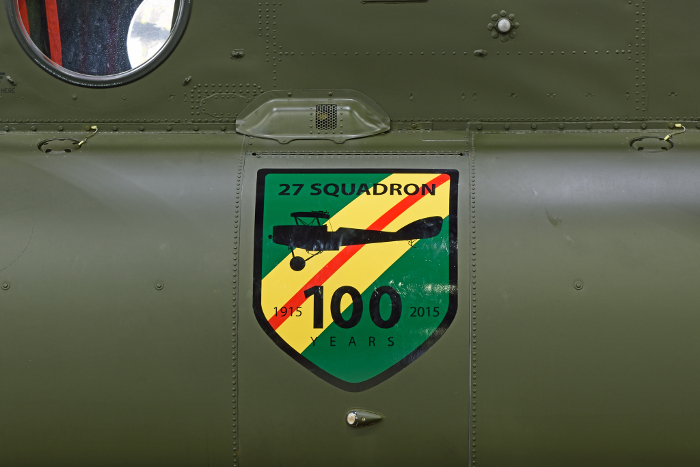
The Elephant is a fairly unknown aircraft but it went onto to feature within the Squadron’s official badge with the latin motto of, “Quam celerrime ad astra”, which translates into, “With all speed to the stars”.
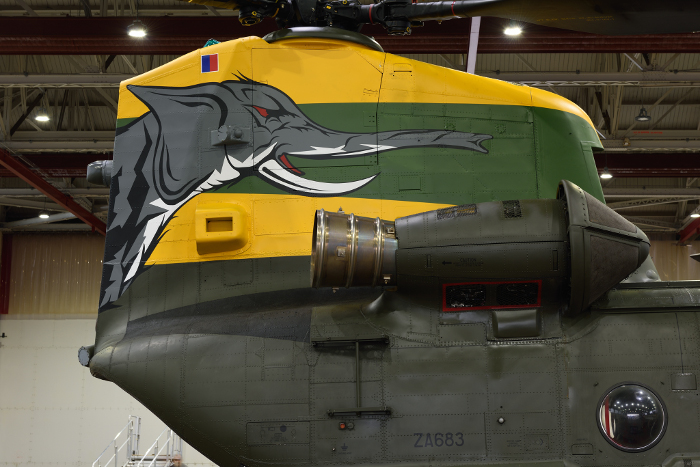
With the centenary of No 27’s creation occurring on 5 November 2015, the Squadron commemorated the event with one of their Chinook HC.4s (ZA683) being adorned with special tail rotor pylon and fuselage artwork.
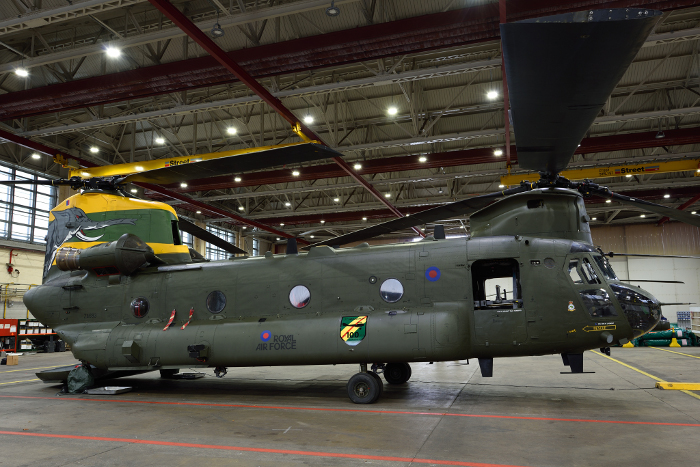
To launch the new scheme a media event was held at RAF Odiham on the anniversary date of the Squadron’s creation and Simply Planes were invited to attend. Present on the day were Officer Commanding 27 Squadron Wing Commander Nicholas Knight, OC C Flight Squadron Leader Hannah Brown, Flt Lt Matt Holloway and Sgt Caldwell.
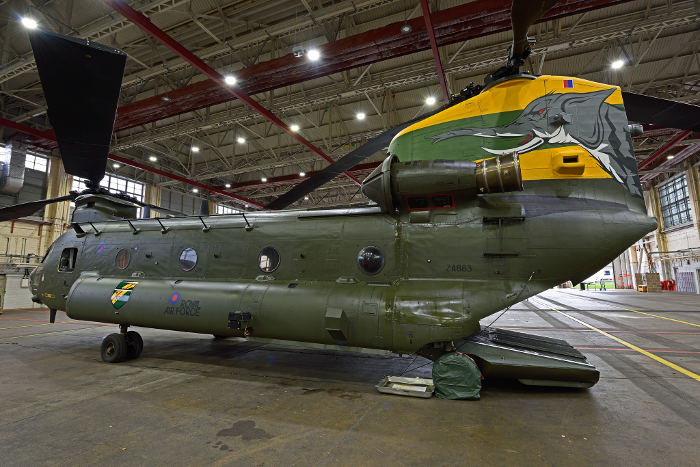
Heavy rain and strong winds kept the Chinook hangered on the day but the opportunity was taken to photograph the new artwork and also to converse with the attending crew. They spoke of the recent upgrades to the Chinook with digital replacing analogue displays within the cockpits and changes to navigation aids. The work undertaken has taken a fairly elderly airframe and transformed it to adapt to the modern aerial environment, which should increase the type’s service life considerably.
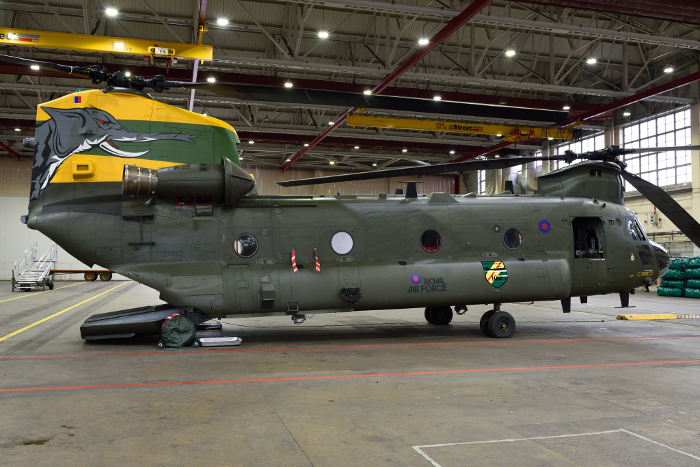
As the event drew to a close the wind and rain continued to make its presence felt across the Hampshire countryside. Out on the field the familiar sound of a Chinook undertaking training could be heard and thoughts went to those who flew in open cockpits in such conditions 100 years ago. It will now not be long before an Elephant is again seen in the skies, a fitting tribute to those who pioneered military aviation in the early days of flight, where there was little in the way of protection with not just the enemy being the foe.
With many thanks to Flt Lt Nyssa Cole & Flt Lt Rachel Potts for arranging the event and for being such genial hosts on the day. Also with thanks to Chris Cannon for the invite to attend the event.
This article and images are courtesy of Richard Hall.




